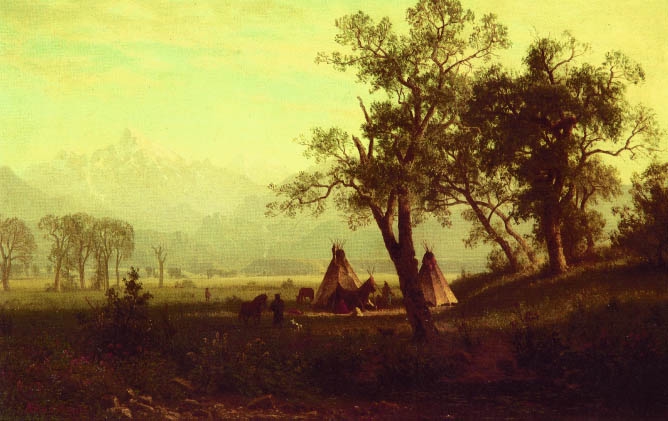
Wind River, 1860, Albert Bierstadt
As noted with regard to the discussion of Fort Bridger, Frederick W. Lander's expedition of
1859 was responsible for the construction of the Lander Cutoff to Soda Springs, Idaho.
The expedition, however, also had the impact of romanticizing a view of the American West.
Included within the expedition were Albert Bierstadt (1830-1902) and Francis Seth Frost (1825-1902). The two
spent five months, three weeks of which were in the Wind River Basin, with the
expedition making sketches and taking stereoscopic photographs. Three of Bierstadt's
sketches appeared in Harper's Weekly.
Upon their return to Boston they each produced epic paintings of the west, utilizing
the sketches and photographs. Bierstadt became one of the leading artists of the
late 19th Century and returned several times to the West including California and
Oregon, with his most famous paintings being of Yosemite.
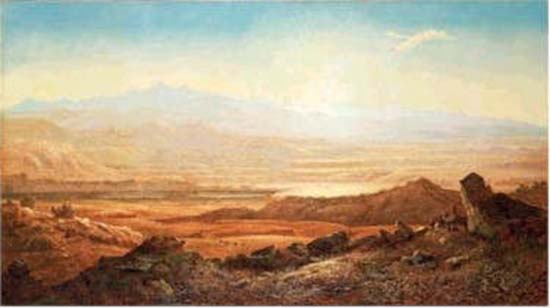
South Pass from Wind River Mountains, 1860, Francis Seth Frost
Frost's career as an artist, however, failed to
materialize and he remained primarily an art dealer. The Smithsonian Inventory of
American Paintings only lists seven examples of his work.
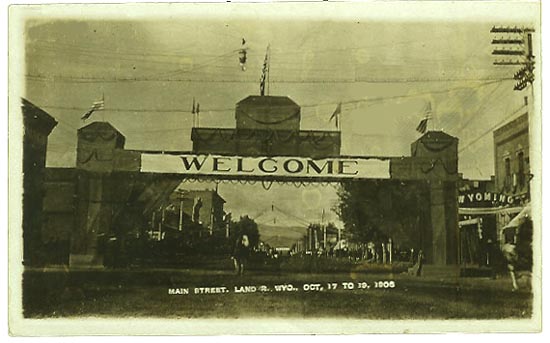
Main Street, Lander, Oct. 17-19, 1908.
In towns such as Lander, it was customary to put up temporary welcoming arches for special events. The
Wyoming on the right-hand side of the photo is the Wyoming Saloon which boasted of the first
electrically illuminated sign in Lander. The building also housed the Odd Fellows lodge.
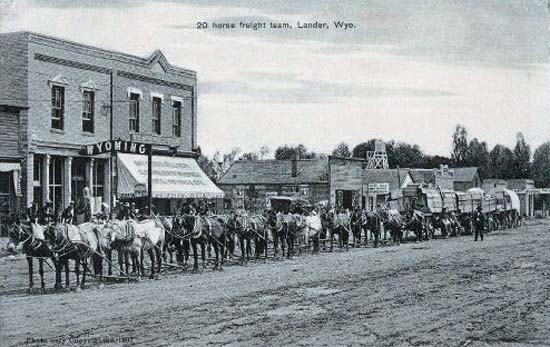
Twenty-horse freight team, Lander, 1906
The use of the streets for freight teams dictated the width of the street. The building next to the sheep wagon at
the end of the train is Wah Lee's Chinese Laundry and Bath.
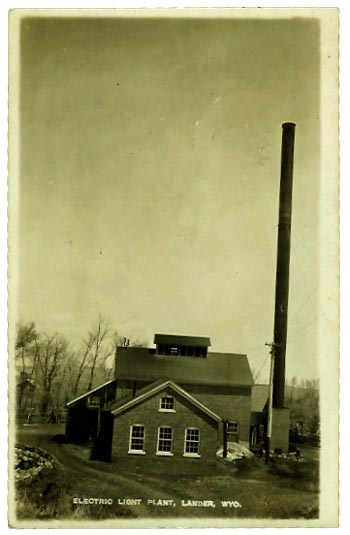
Lander Electric Plant 1908
Although settlement near Lander did not began until 1869 with
the establishment of Camp Augur, named after Brevet Major
General Christopher C. Augur, many of the early expeditions passed through the
Wind River area. In 1856 Ramsay Crooks, one of the original Astorians,
described in a letter to the Detroit Free Press an
expedition through South Pass:
Mr. David Stuart sailed from this port [New York] in 1810
for the Columbia River on board the ship 'Tonquin' with a number of Mr.
Astor's associates in the 'Pacific Fur Company,' and after the breaking
up of the company in 1814, he returned through the Northwest Company's
territories to Montreal, far to the north of the 'South Pass,' which
he never saw.
In 1811, the overland party of Mr. Astor's expedition, under the command
of Mr. Wilson P. Hunt, of Trenton, New Jersey, although numbering sixty
well armed men, found the Indians so very troublesome in the country of
the Yellowstone River, that the party of seven persons who left Astoria
toward the end of June, 1812, considering it dangerous to pass again by
the route of 1811, turned toward the southeast as soon as they had crossed
the main chain of the Rocky Mountains, and, after several days' journey,
came through the celebrated 'South Pass' in the month of November, 1812.
Pursuing from thence an easterly course, they fell upon the River Platte
of the Missouri, where they passed the winter and reached St. Louis in
April, 1813.
The seven persons forming the party were Robert McClelland of Hagerstown,
who, with the celebrated Captain Wells, was captain of spies under General
Wayne in his famous Indian campaign, Joseph Miller of Baltimore, for several
years an officer of the U. S. army, Robert Stuart, a citizen of Detroit,
Benjamin Jones, of Missouri, who acted as huntsman of the party, Francois
LeClaire, a halfbreed, and Adré Valée, a Canadian voyageur, and Ramsay
Crooks, who is the only survivor of this small band of adventurers.
I am very sincerely yours,
RAMSEY CROOKS.
The Rendezvous of 1829 was held near present day Lander.
Captain Benjamin L. E. Bonneville's expedition of 1833 discovered an oil spring
in the Wind River Basin and was the first to take wagons through South Pass. Ostensibly
Bonneville's expedition was private. In reality it was at the behest of the
government and was for the purpose of spying on the British who were active
in the Pacific Northwest. The first oil well, Murphy #1, in the Territory was drilled in
Lander at Dallas Field, southeast of Lander in the vicinity of Captain Bonneville's
"Tar Sring," in 1883 by Mike Murphy. The Tar Spring had been discovered by mountain men in the Ashley Party.
The field is still in production. Washington Irving in his
1837 The Adventures of Captain Bonneville described the re-discovery of the spring:
Proceeding down along the Popo Agie, Captain Bonneville came again in
full view of the "Bluffs," as they are called, extending from the base
of the Wind River Mountains far away to the east, and presenting to the
eye a confusion of hills and cliffs of red sandstone, some peaked and
angular, some round, some broken into crags and precipices, and piled up
in fantastic masses; but all naked and sterile. There appeared to be no
soil favorable to vegetation, nothing but coarse gravel; yet, over all
this isolated, barren landscape, were diffused such atmospherical tints
and hues, as to blend the whole into harmony and beauty.
In this neighborhood, the captain made search for "the great Tar
Spring," one of the wonders of the mountains; the medicinal properties
of which, he had heard extravagantly lauded by the trappers. After a
toilsome search, he found it at the foot of a sand-bluff, a little east
of the Wind River Mountains; where it exuded in a small stream of the
color and consistency of tar. The men immediately hastened to collect
a quantity of it, to use as an ointment for the galled backs of
their horses, and as a balsam for their own pains and aches. From the
description given of it, it is evidently the bituminous oil, called
petrolium or naphtha, which forms a principal ingredient in the potent
medicine called British Oil. It is found in various parts of Europe and
Asia, in several of the West India islands, and in some places of the
United States. In the state of New York, it is called Seneca Oil, from
being found near the Seneca lake.
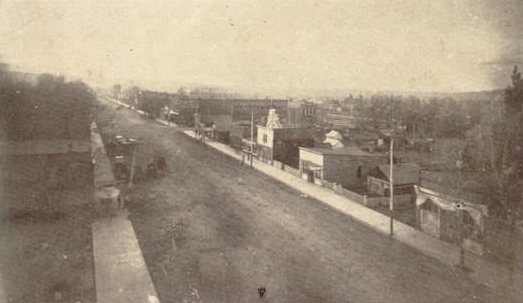
Lander, Wyo., 1910
Lander Photos continued on next page.
|